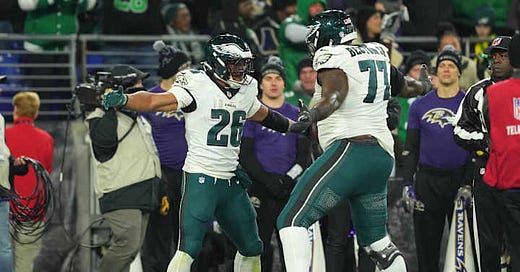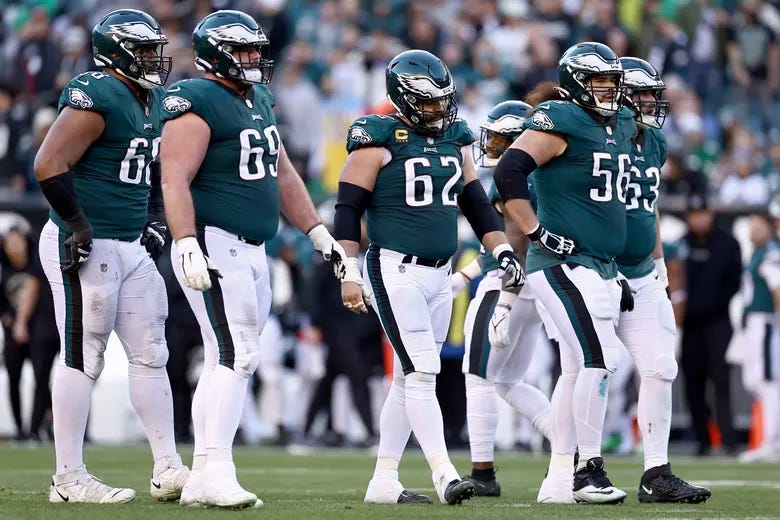Foundations: offensive and domestic
"Necessary but not sufficient" and the hidden tale of the Eagles success
Some of you may be surprised to know that I actually love — LOVE — watching football. I love the game. I hate the NFL, I despise the “shield,” but I love the game.
Framing the QB -- and the OL
On TV, the broadcast angle looks like this:
As soon as each play starts, the wide receivers and secondary (the guys who catch passes and try to stop passes from being caught) run out of the frame and the camera zooms in on the Quarterback (the guy who holds the ball and decides where to throw it, or hands it to someone, or runs with it, or gets tackled 🫣).
I would much rather see all of the players on the field at once,1 but I understand why the TV frame focuses on the Quarterback (QB). In all of team sports — literally — there is no position that is more powerful or important than the quarterback. If a quarterback is successful, the whole team’s offense will be successful. If the QB screws up, the whole team is screwed.2
But the camera also shows what’s known as the “pocket” (above), the umbrella shaped wall of protection that the Offensive Line (OL) attempts to maintain long enough for the QB to throw the ball. Their opponents are collectively known as the Defensive Line (DL). These are the big boys, the absolute units, the titanic giants of men, pushing and shoving and wrestling with each other to try to gain advantage.3 You would not be alone in finding these guys either boring or dumb or both, but let me tell you: do not underestimate the OL and DL battles.
Offensive linemen are routinely the smartest players on the field. They’re definitely the heaviest, which many assume means they’re just big lugs who are valued for their girth more than their capacity to interpret and understand the game. But let me assure you: these guys are geniuses (genii?) at setting protections, passing off stunts, recognizing and picking up blitzes, understanding and responding to simulated pressures, and blocking for the run. Each of these tasks are subtle and complicated on their own, but having to achieve each of these responsibilities at a high level while reacting within milliseconds to the violent mauling the DL is inflicting on you is nothing short of heroic. Don’t underestimate how incredible it is that OLs successfully keep DLs at bay.
However, you wouldn’t be alone in underestimating the value of an OL. PLENTY of football teams spend extensive resources on the extras — picking up flashy and athletic pass catchers and running backs — all while ignoring or neglecting the OL. It’s super common. Why? Because OL play isn’t always the sexiest. When an OL is playing well, you don’t hear about them. You’ll hear about the big QB pass or massive RB run, but it rarely is described as a “win” for the OL.4 Most of us can focus on the person with the ball running untouched in wide open space but can’t recognize the work that went into ensuring no one was within five feet of touching him.
Growing up, I watched a lot of football with my dad and siblings. In the Chicago area, this meant watching the Bears — traditionally terrible at football, even to this day. My sister would routinely get frustrated at watching Bears running backs get handed the ball only to run straight into a pile of massive men and get tackled. “Why don’t they run around the pile?!” she would ask, reasonably. I’ll tell you why: because that pile wasn’t supposed to be there. That pile of dudes falling over is the result of bad Offensive Line play: guys who either made mental errors or simply were not strong enough to clear a path for the running back to run freely. They were given a job to do, and they didn’t do it. As a viewer, it’s easy to blame the running back for making a bad decision (and truly, sometimes it really is the RB’s fault for not reading the play correctly), but it’s more likely the fault of the OL for being overcome by the strength, intelligence, and violence of the DL.
Both teams in the Super Bowl this year have spectacular OLs. The Eagles, specifically, are famous for always having a fantastic OL. That’s in part due to savvy free agent signings and wise drafting practices, but it’s also the result of the Eagles having the best OL coach in the world: Jeff Stoutland. When the Eagles sign a new offensive linemen, he’s enrolled as a student in Stoutland University, the world’s premier destination to turn good linemen into hall of famers.
The Eagles current offensive line:
Left tackle: Jordan Mailata, 6’8”, 365 lbs. Former rugby star, hadn’t played American football before being drafted by the Eagles.
Left guard: Landon Dickerson, 6’6”, 332 lbs.
Center: Cam Jurgens, 6’3”, 303 lbs.
Right guard: Mekhi Becton, 6’7”, 363 lbs. A NY Jets cast-off, signed by the Eagles last offseason. A Stoutland University reclamation project success story.
Right tackle: Lane Johnson, 6’6”, 325 lbs.
Together, that’s 1688 lbs of OL. 120.5 stone. 765 KG. That’s a lot of beef.
If these guys play well, the Eagles really could win. If they don’t… there’s no way the Birds will win. And when these guys play well, hooooooo boy. There’s nothing more satisfying than dictating the game with a dominant OL. The defense could know exactly what the offense is about to do and yet be unable to stop it, because the OL is just too big, too strong, too smart, too athletic. In games like this (of which the Eagles have played many this season), they just push the defense around. The Chiefs defense is too good for this to occur tomorrow, but there’s a chance…
The best example of this is the Tush Push, or Brotherly Shove. Here’s a video explaining why it’s so cool and effective:
Necessary but not sufficient
It’s hard to appropriately value a strong offensive line because a good offensive line is necessary but not sufficient to being a good football team. In other words, without a good OL or DL, you don’t have anything. You still might not be good at football even if you have a good OL or DL, but the opposite is not true.5
Having a good home is similar to having a good offensive line. In fact, it’s similar to having a strong foundation for not just your house, but your whole life. Having a good home is not sufficient to having a good life. But having a good home is necessary to having a good life. Having a good home is a platform towards other forms of freedom, choice, or power that are FAR MORE DIFFICULT without a solid answer for where you’ll live.
In your life “build,” you might be tempted to invest in the flashy stuff — consumer products, cars, investments, etc. — and ignore your housing situation. But where you keep your stuff and spend most of your time is fundamental. It’s a foundation from which everything else can grow.
You’re the QB, your home is your OL
You are the quarterback of your life. You are the one choosing how to go about living the way you want to live. But those choices are either harder or easier based on the ecosystem within which you operate — how many decisions are made for you so that you can focus your energy on the more difficult or important things.
Spending your whole life worrying about basic elements of survival is a tough way to live, and too many of us live this way. In fact, the powers that be — the billionaires, the capitalists, the vampires, etc. — profit and grow their power by keeping you destabilized and exhausted. A boss has more leverage and power over a precarious worker than a stable worker.
Getting your housing situation to a stable and strong position is similar to investing in your offensive line. It might prove to be sexy and exciting, like this…
…but it could also be the simple, basic, fundamental strength that lets the rest of your life bloom. You might not think about the foundation behind why other parts of your life start functioning and working well, but your foundation will be no small part of the reason why. Like this:
So when you watch the Eagles and Chiefs this Sunday, watch the big boys up front and be reminded of the power of a good foundation. Both teams invested in the OL and DL, which supported them through this process of making it to the Super Bowl. And when Saquon inevitably breaks off a massive touchdown run, remember to watch the offensive linemen huffing and puffing beside and behind him, ready to celebrate.
GO BIRDS!
It’s called the “All-22” angle because it shows, as you might guess, all 22 players, 11 on offense and 11 on defense. If you really want to understand what the QB is seeing and what the pass catchers and secondary are doing, this is a really fun angle to watch the game. Only Amazon Prime Video lets you watch the game live from the All-22 angle, but it’s of Thursday night games only, which typically suck. Nobody likes playing on Thursday night.
For a long time, turnover differential was the best predictor of success in football. That is no longer the case: quarterback success is now more predictive of wins and losses.
Football teams typically have 5 offensive linemen and 4 defensive linemen, but that can vary.
By contrast, when a DL is playing well, you’ll hear about them every single play — sacks and busted plays galore. A great pass rusher will make the entire offense look like kids playing against grownups. Both the Eagles and Chiefs have spectacular pass rushers: Chris Jones (number 95) for the Chiefs and Jalen Carter (number 98) for the Eagles. You’ll be able to see them right in the middle of the defensive line on virtually every snap. If you’re not sure what to look at while watching the defense, just watch those dudes — especially if the OL decides not to double-team them. I guarantee it will be entertaining.
There is one exception to this that I can think of: the Cincinnati Bengals, who made it to the Superb Owl in 2021 despite having a swiss cheese OL. Their QB and WR combo — Joe Burrow and Jamarr Chase — were simply so talented that the lousy line didn’t really trip them up… until the Super Bowl. They didn’t win in large part because their OL couldn’t protect their QB long enough to let him pass successfully.







